
How Often Should You Text Your SMS Marketing Subscribers?
Fatigue.
It’s a word feared by marketers everywhere. Whether you’re running too many similar ads or sending too many similar emails, when your audience gets tired of your messaging, they’ll stop engaging with it (or worse, unsubscribe from it). This not only dampens the effectiveness of your marketing overall, but can also damage your brand—which means fewer sales and less revenue. It’s basically a marketer’s worst nightmare.
Fatigue can be even more of a concern in a channel like SMS, because it’s (1) relatively new, and (2) way more intimate than any other type of messaging. But those two attributes also make it much more powerful than any other type of messaging. The challenge is figuring out the strategy that enables you to use that power to the fullest.
When done well, SMS marketing can be a top—if not the top—revenue driver for ecommerce brands. And one of the biggest factors in building an effective SMS marketing strategy is finding your sending “sweet spot.” And it's less about the best time to send an SMS blast, but more about how you're sending.
Which begs the question: How often should you text your subscribers? The answer may surprise you. (Spoiler alert: If “less is more” is your text message marketing mantra, then you’re probably underutilizing the channel.)
Let’s dive in.
In this article (click to jump to a particular section):
Data shows that sending more texts does not have a substantial impact on unsubscribes.
First, let’s bust this widespread myth to smithereens. Many brands believe that increasing their send rate will lead to subscriber fatigue and annoyance—which will lead to a massive spike in unsubscribes.
Not true.
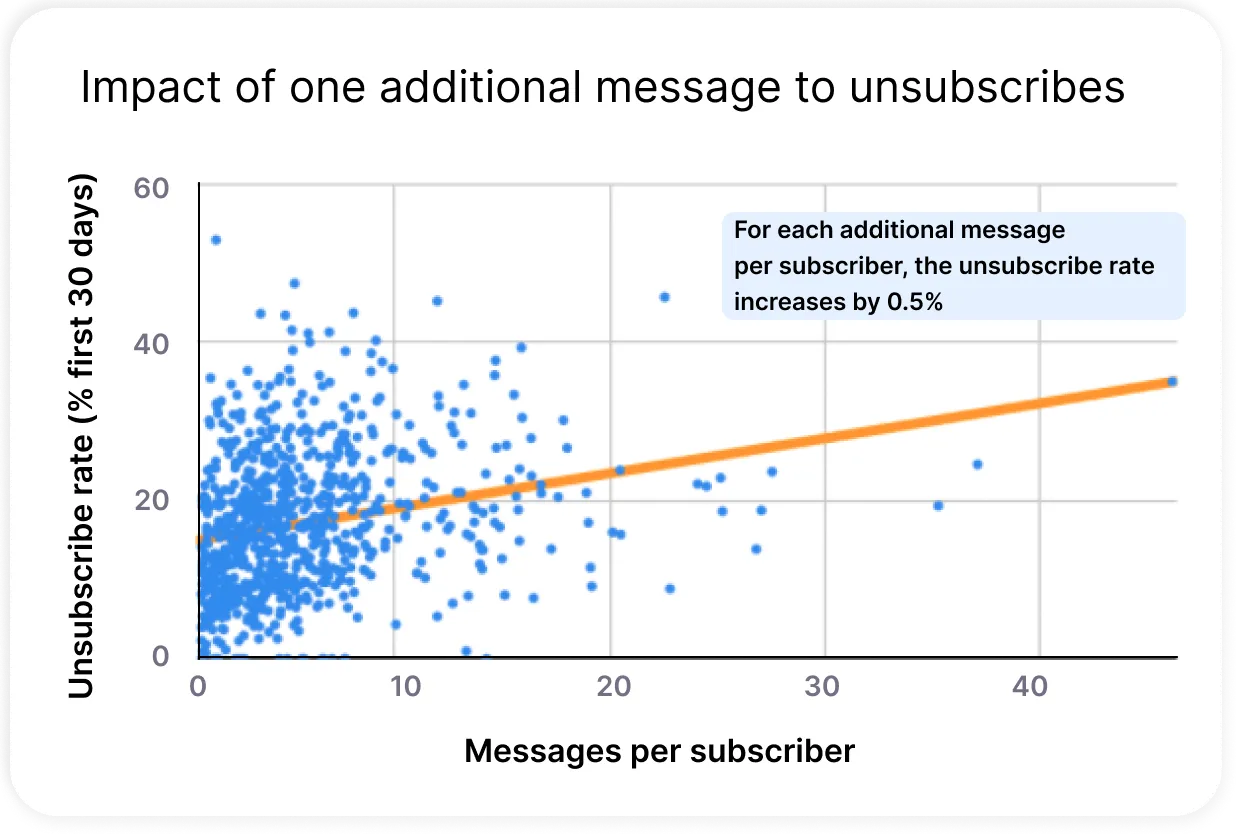
In fact, the Postscript data team found that even during a subscriber’s first 30 days on your list—a period notorious for high unsubscribe rates—each additional send only raises unsubscribes by about a half of a percent (0.5%). That’s basically nothing considering that a 20% unsubscribe rate during this window is considered great.
As we explain here, “This means that hypothetically, sending one more message to a list of 1,000 subscribers would result in only 5 additional unsubscribes.”
To further put that into perspective, losing 5 subscribers would cost you an average of $100 in the long run (based on the average Subscriber Lifetime Value of $20).
But sending one SMS marketing campaign to a list of 1,000 subscribers would earn you an average of $360 in additional revenue (based on the median campaign EPM of $0.36).
So theoretically, you’d come out $260 ahead—and that’s on the conservative end, because we’re talking about average performance for one of the lowest-earning text message types overall (campaigns).
Ecommerce brands should be able to send each subscriber 5 text messages per month without seeing a higher unsubscribe rate.
Translation: Your subscribers are a lot more tolerant than you think they are. (Though that shouldn’t come as a surprise since they did sign up to get texts from you!)
During the same data analysis cited above, our team found that the merchants who achieved an optimal balance of earnings per message (EPM) and unsubscribe rates texted their subscribers 5 or more times per month.
So, if you’re not sending each SMS subscriber at least 5 text messages per month, then you’re probably leaving money on the table.
If you use Postscript, you can see your average number of messages per subscriber right on your main account page in the Subscriber LTV Dashboard. Have a score below 5? It’s time to ratchet up your send volume!
Then, keep a close eye on your unsubscribe rate—which is also available in real time right on your Subscriber LTV Dashboard. You should be able to get to 5 messages per subscriber without seeing a substantial effect on your unsubscribe score. (If you’re already at 5 or more messages per subscriber, you should still test adding more sends to see how it affects your unsubscribe rate and the rest of your Subscriber LTV metrics. You might be missing out on revenue you didn’t even know you could be generating!)
Now, if increasing your messages per subscriber to 5 causes your unsubscribes to soar, then there might be an issue with your list health. And in that case, a little bit of unsubscribe pain now could mean much higher returns later.
“People are so scared of unsubscribes, but the reality is that if these people aren’t going to make a purchase or engage with your brand, then you don’t really want them on your list,” said Liza Semenova, a Client Messaging Strategist here at Postscript. “That’s just wasting money on people who are never going to convert.”
So if ramping up messaging prompts some subscribers to bail initially, don’t panic. It’ll most likely set you up for better conversion rates on future sends.
She pointed to beauty brand Kopari as a perfect example. When Kopari started sending more full-list campaigns, unsubscribes increased initially—but in the end, the increased revenue they generated made it more than worthwhile.“At the end of the day, it’s more important [to Kopari] to capture more revenue versus keep people [on their list] who were never going to convert,” Semenova said.
And now? According to Semenova, Kopari continues to text their full list about twice per week, and their unsubscribe rate remains well below 1%.
It’s also important to refrain from comparing email marketing unsubscribes with SMS marketing unsubscribes. As Postscript Customer Success Manager Kara Morin put it, “If we divided your open rate by your unsubscribe rate on email, it would be much higher—it’s just that everyone opens texts.”
Semenova continued, “What does it matter if someone is on your email list if they just sit there? If you’ve seen our best offer multiple times and you’re still not going to engage, I don’t want you on my list.”
Now, if you get a few months down the road and unsubscribes continue to exceed the norm, then there’s a good chance you’ve got a problem with your message content or subscriber segmentation.
Here’s how to course-correct.
Set clearer expectations upfront.
What happens during a subscriber’s first 30 days on your SMS marketing list will make or break their value to your business.
That’s largely because, as we alluded to above, they are 5 times more likely to unsubscribe during this time period than they are at any other point in their SMS journey.
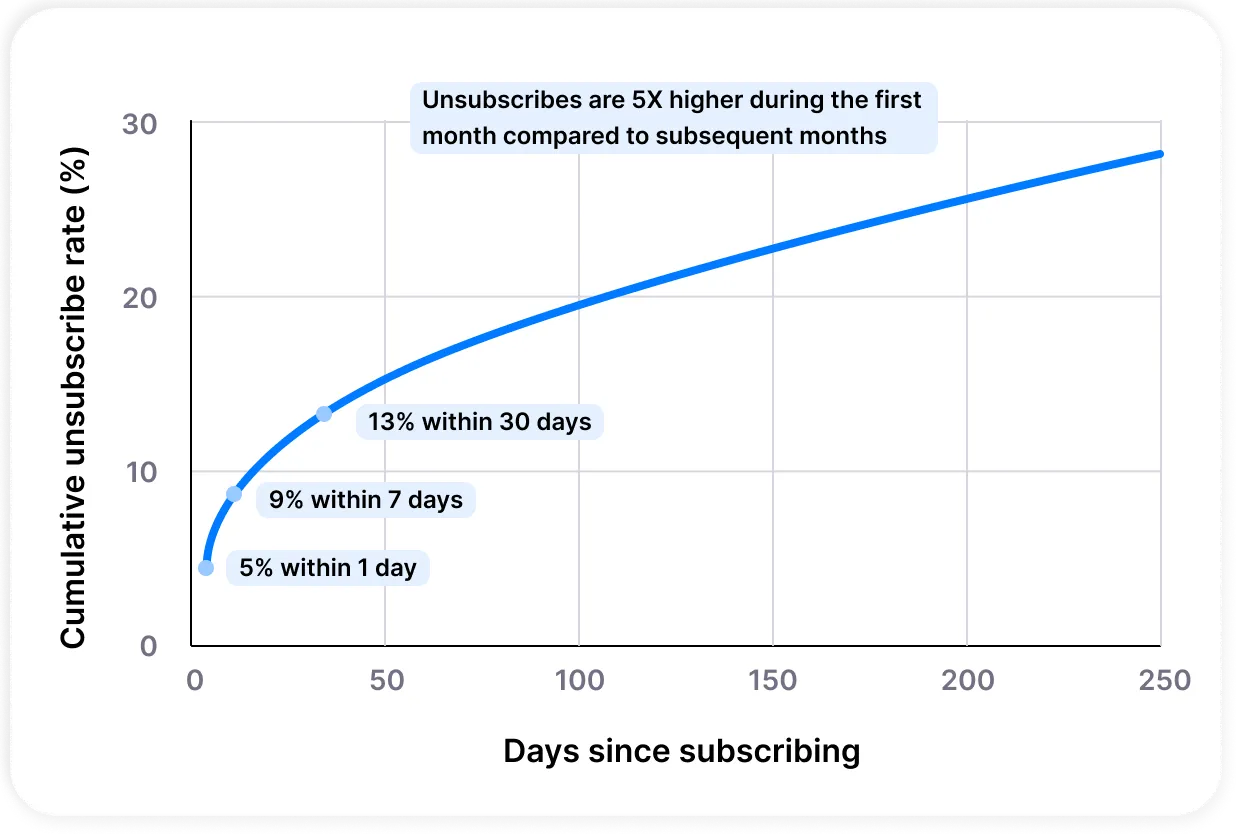
Sure, you’re always going to have those subscribers who bail the moment they use their incentive discount. But the fact that they wanted the incentive in the first place is proof that they are interested in your brand and products. You got their attention—and now it’s up to you to keep it.
If you do so successfully—and get them past that first 30 days—then your ROI on this marketing channel will soar.
Enter: the welcome series.
This 2–4 message flow sets the stage for the rest of the subscriber’s SMS journey with your brand. Folks will be much more receptive to the messages you send down the road if you tell them what kinds of messages they can expect to receive—and how often.
As you build out this series of messages, think about what drives subscribers to sign up for your texts in the first place. Do they subscribe to get early access to new product drops? First dibs on major sales or deals? Instant discounts or savings? Whatever it is that incentivized them to sign up, be sure to communicate that they can expect more of the same if they stay subscribed.
Here’s a short-and-sweet example from clothing brand Soft Serve.

Successful brands also use the welcome series to:
Introduce their founders, origin story, mission/purpose, and products.
Tease other types of messages and content sent exclusively to SMS subscribers (e.g., playlists, recipes, calls for product feedback or votes, event invitations, one-on-one access to the founder).
Ask new subscribers what types of messages and content they are interested in receiving (so you can better segment future sends to deliver relevant information only).
For more welcome series tips, insights, and examples, be sure to check out this blog post.
Mix up your message content.
Just because a subscriber opted in so they could get 15% off their next purchase doesn’t mean they only want you to send them texts containing discounts.
It is possible to get too much of a good thing. Remember that whole fatigue discussion? Yes, it applies to sales and coupons, too.
“Not everything needs to be a sale; not everything needs to be a new product launch,” Semenova said. “If you’re just sending your list the same thing over and over, their eyes are going to glaze over.”
Variety is the spice of life—and text message content. As humans, we crave novelty. And as a brand, you can satisfy that craving by consistently serving your subscribers new and interesting information and experiences.
For example, while it may seem counterintuitive from a conversion optimization standpoint, sprinkling non-CTA-focused messages into your campaign schedule can be a great way to spark subscriber delight. (Bring on those warm fuzzies!)
Here’s a super simple example BILLY Footwear sent to their SMS subscribers on World Gratitude Day.

And here’s one beauty and wellness brand EDEN BodyWorks sent in celebration of Women’s Equality Day.

And on the topic of CTAs—keep in mind that not all of them need to be (or should be) purchase-related. Ask subscribers to answer a trivia question or check out a new recipe, blog post, or playlist.
This is something Semenova strongly recommends to her clients. “[I’ll say] let’s do an engagement play, let’s do something fun—text us to get your horoscope, give us feedback, tell us your favorite product or favorite [past] collection and maybe we’ll bring it back,” she said.
While Semenova said many brands love the concept of engagement-focused texts because “even if it doesn't drive revenue it connects with their audience,” this strategy can actually pay off in a big way because it helps you identify subscribers who are willing to engage with you in two-way conversations.
Why is that important? Because in the words of Postscript President and Co-founder Alex Beller, “Subscribers who respond to a conversational campaign and then receive a personalized response from the brand are worth 4x more than the average 1-way subscriber.”
We featured tons of conversational campaign examples here and here, but here are a few ideas to get your creative juices flowing.
In this response-based campaign, pizza oven brand Gozney asked subscribers to reply with their answer to a trivia question.

You could also spark one-on-one engagement by asking subscribers questions about their personal interests—whether or not they are related to your products. Here’s an example from hydration brand Hydrant.

Or, crowdsource product feedback, reviews, or UGC via text. All of these “asks” mobilize subscribers in ways that don’t require them to spend money—but still deliver value to your business and keep your brand top-of-mind.
As the former Director of Marketing at RAREFORM, Morin knows that sourcing good UGC can be expensive and difficult—but crucial to generating digital word-of-mouth. “The product alone is not the only reason people buy stuff,” she said. “People are convinced by stories, and if UGC can help your tell your brand story more authentically, that’s a huge win.”
Sure, you can pay an influencer to tag your brand on social media, but there’s probably a large segment of customers who don’t feel comfortable putting themselves out there on their own social handles. SMS is a different story, though. The intimate nature of the channel feels more private, and many customers who wouldn’t post a product photo on their own Instagram Story, for example, may be totally cool with texting your brand a pic to post on your accounts.
“When I added a post-purchase text asking them to send a selfie of themselves with the bag, we would get like 7–8 a day,” Morin said of her strategy at RAREFORM.
Here’s an example from Tenth Street Hats.

In addition to collecting content that’s valuable to you, use SMS to send your subscribers content that’s valuable to them. Give them a tip or an educational blog post or video—whether or not it’s directly related to your products.
Home composter brand Lomi achieved incredible results with a content-focused strategy—increasing their messages per subscriber by more than 46% while actually reducing unsubscribes by more than 8% over the course of 30 days.
Before they made this change, they were essentially sending one message a week to buyers and one message a week to non-buyers. Morin encouraged them to double that cadence and start using SMS to promote some of their educational materials rather than simply push their products.
“They’ve done super well with a content-based approach,” Morin said. “It makes sense, because someone who is willing to spend $500 on a composter is probably pretty invested in sustainability, so they are interested in that kind of content.”
Here’s a recent example providing tips for low-waste grocery shopping.

Despite having a high-value flagship product, Lomi has seen solid earnings per message with their increased send frequency.
They also added some reminder flows for those who have already purchased composters, as users need to change out the filters every few months to keep the device running optimally.

As for non-buyers, in addition to sending them educational content and reviews/UGC from happy customers, Morin says Lomi has seen a lot of success with informing (and reminding!) subscribers of their various payment options through providers like Affirm. This is a great strategy for any brands selling high-ticket items.

Segment your sends.
Beyond helping you separate engaged subscribers from unengaged subscribers, conversational messages give you the ability to segment subscribers in highly strategic ways. In fact, we’d say response-based campaigns are hands-down the best tool for collecting zero-party data in a way that feels natural and organic to subscribers. You can then use that data to segment future sends based on subscriber interests, behaviors, or attributes.
Here’s an example of a New Year’s campaign herbal formula brand Organic Olivia sent asking subscribers to reply with their top health goal for 2022.
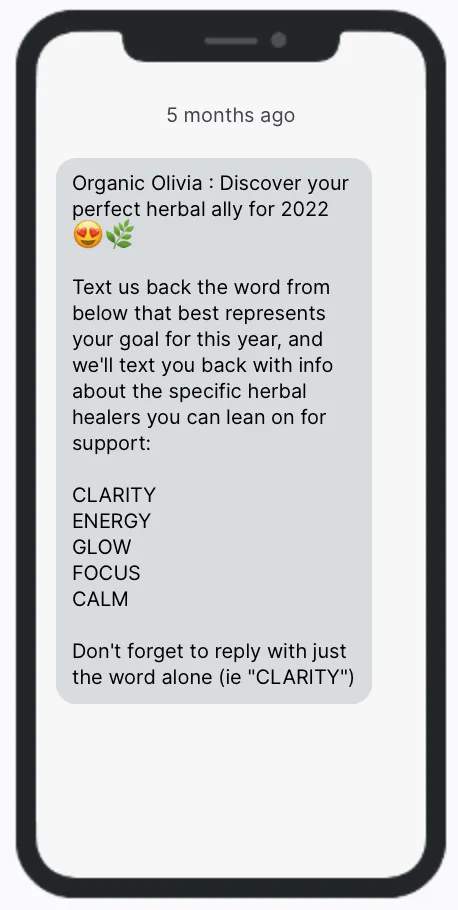
Sending a conversational campaign like this enables you to not only reply immediately with targeted content or product suggestions, but also create goal-based segments for future campaigns.
This equips you to more consistently achieve the trifecta of effective SMS marketing: sending the right message to the right subscriber at the right time.
Good segmentation alone can help you increase message frequency without sacrificing subscribers, because the more relevant and contextual your messages are, the more receptive your audience will be to receiving them.
But even if you haven’t really dipped your toe into zero-party data collection, you can still use the first-party data available through Postscript’s robust Shopify integration to tweak your messaging for different groups of customers.
For example, you might send those who’ve spent more than $100 in your store a different message than those who’ve spent $10—or you might send a different post-purchase follow-up message to those who purchased coffee versus a coffee mug. You could even segment by geographic location to tailor your messaging to local events, attractions, or weather conditions.
Here’s a simple example from nutrition brand Perfect Keto. They sent the first version of this post-purchase cross-sell automation to customers who had purchased Keto Collagen but not Keto Bars.

And they sent this version to those who had purchased Keto Bars but not Keto Collagen.

Ski brand J Skis uses geotargeting (based on area code) to send different versions of their welcome series to subscribers located in different parts of the country. For example, here’s the version that goes to the California segment.
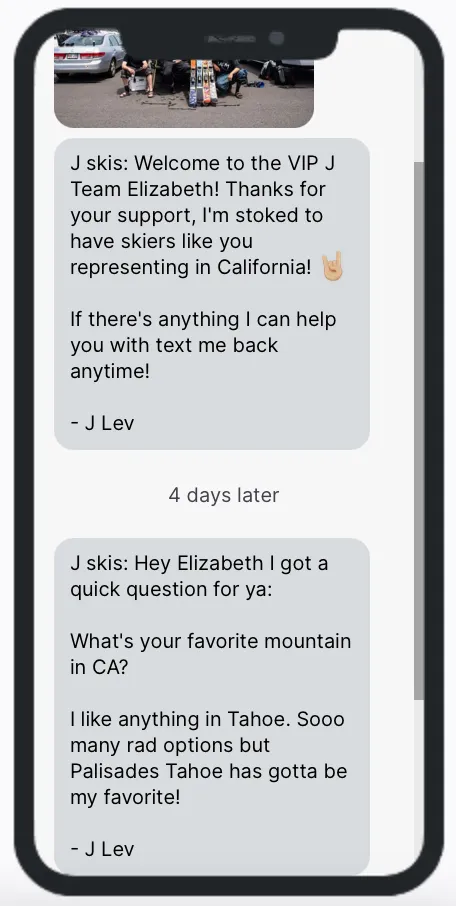
And here’s the version that goes to the Pacific Northwest segment.
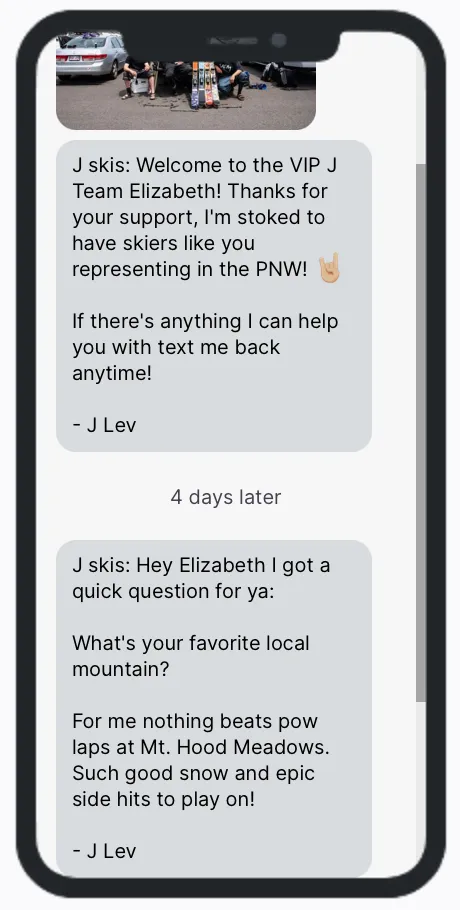
The possibilities for segmentation are endless—and the more targeted you get, the lower your chances of pushing people to leave your list, even when you increase your send cadence.
But, don’t be afraid to text your full list.
While Morin believes segmentation is great for adding more personalized messaging to your send mix, she cautions against overusing it—especially if your list is healthy.
To get a sense of list health, Morin recommends creating an “unengaged” bucket of subscribers who have never interacted with you (e.g., never clicked, ordered, or triggered any action-based automations). Those unengaged subscribers should make up no more than 10–15% of your total list.
“If you’re in the healthy range, then you can probably afford to send to everybody,” Morin said. “As you send more, you’ll drive up revenue—without having to spend a lot of time writing different versions of messages for different segments.”
But what if that unengaged bucket accounts for 20–40% of your total subscribers (or, gulp, more)?
“That list isn’t healthy,” Morin says. “So continuing to send to the whole list will drive up your messages per subscriber, but it won’t drive up revenue in a way that’s beneficial.”
If you find yourself in that situation, Morin recommends sending that segment an engagement-focused text. “Try a keyword mystery offer,” she said. “Something like, ‘Hey, it’s been a while since we’ve heard from you. Want a deal? Reply MYSTERY to reveal it. Not interested? Reply STOP to unsubscribe.’”
Morin suggests running this type of re-engagement campaign once per quarter to help keep your subscriber list clean. “Even if it only generates a few purchases, it will pay for itself because you’re getting people back into the engaged group,” she said.
Set up more subscriber-triggered automations.
Another great way to bump up your message volume is setting up more automated messages that fire only after a subscriber takes a specific action. This strategy has the added benefit of increasing the relevancy of your texts.
In addition to building out classic automations like your welcome series, abandoned carts, and browse abandonment messages, consider creating targeted post-purchase automations, winbacks, or back-in-stock notifications.
Postscript offers dozens of triggers and filters you can use to set up highly specific automations. For example, you might create a winback automation for customers who have purchased a certain number of times previously, or whose total spend exceeds a certain threshold.
Here’s a winback flow Death Wish Coffee sent to customers who purchased once before. The first message reminds them to order again, and the second one promotes a newly released product.
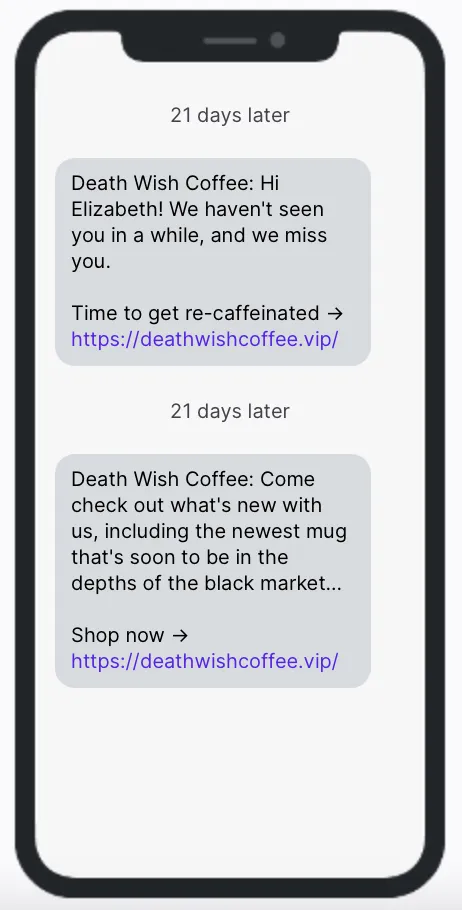
The version that went to customers who purchased twice plays on their budding loyalty by promoting Death Wish’s subscription option. The idea here is that they are already repeat buyers. So rather than nudging them to make another standalone purchase, Death Wish highlights the benefits of purchasing a subscription (which gives members 10% off every order in addition to free shipping).
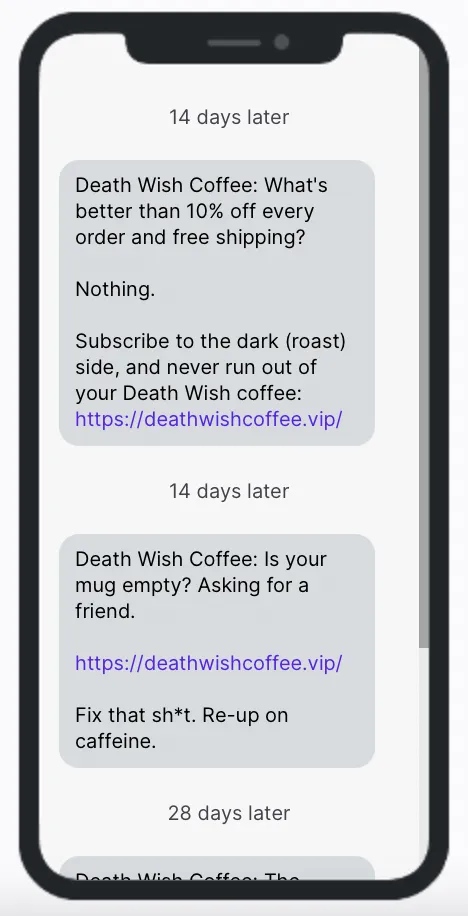
The more automations—and versions of those automations—you set up, the more chances you’ll have to capitalize on high-intent subscriber behavior. Hello, higher click-through rates and increased conversions!
To see ideas, examples, and optimization tips for 7 major automation types available within Postscript, check out this blog post.
Create amazing post-order experiences via text.
Cost is a concern for many merchants who are thinking about sending more texts. After all, it’s not “free” like email.
This can deter some brands from dedicating too many messages to customers who recently purchased—especially if it’ll likely be a while before they’d consider buying again.
Morin’s counterargument? “Think about how much you’re spending on packaging, stickers, etc. to create this great unboxing experience,” she said. “If you think about it, it’s less than a penny to send a text to create a better brand experience by telling the customer when their order ships or when it’s out for delivery.”
Beyond order-related messages, this idea also applies to providing product education to build excitement and drive adoption.
“There’s so much value in curating your community and showing customers that you’re interested in what they do after they purchase from you,” Semenova added, noting that Kopari has seen this type of messaging make a direct impact on customer experience. “They saw that their customer base was pleased with the additional communication and follow-up and felt better about the customer service they were receiving. On the back end, it’s all automated—it’s simple for the brand to set up. But from the customer perspective, it feels so much better—so much more considerate.”
Subscriber LTV is the North Star metric for all aspects of SMS marketing success, including message frequency.
As you experiment with the types of texts you send—and how often you send them—remember that when testing any SMS marketing strategy, Subscriber Lifetime Value (LTV) should always be your North Star for measuring success.
You can see benchmarks for Subscriber LTV and its feeder metrics (ARMR) here. And remember, Postscript customers can always view their Subscriber LTV and ARMR scores in real time on their Postscript Dashboard.
The main thing to keep in mind is that any changes you make to your SMS strategy—including texting your subscribers more often—are good for the overall health of your SMS program as long as your Subscriber LTV score continues to rise.
This is how top brands find their sending “sweet spot”—they increase messages per subscriber until they start seeing a negative impact (or no impact) to their Subscriber LTV score. Then they either pull back or look into improving their message content and segmentation, as we discussed in the previous section.
Many brands are surprised by how many texts they can send without diminishing their returns. And if you haven’t tried sending each subscriber more than 5 texts a month, there’s a good chance you have yet to realize your brand’s full SMS revenue potential.
Want to see more tips for making SMS your brand’s number-one revenue channel? Check out this blog post and this page on optimizing Subscriber LTV.
Not on Postscript yet? We’d love to help you create a data-driven SMS strategy—including finding the exact right messaging frequency for your brand. Start your free 30-day trial here, or get in touch with our Textperts here.



